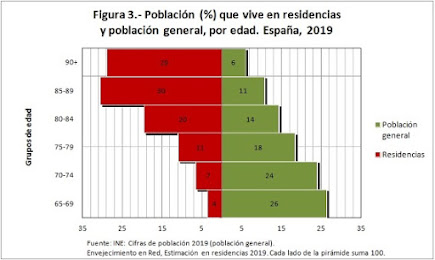The Spanish Law on Dependency (Ley de Dependencia)
One of the greatest XX century achievement has been the increase in life expectancy of mankind, specially people living in Spain and other western countries, brought about by, among other factors, the improved public health and welfare conditions. Over the last 45 years, Spanish development model has enabled an increase in the number of people reaching old age and doing so in a situation of relative financial stability. However, the increase in life expectancy coupled with a significant drop in the birth rate over the last 30 years has led to a rapid transition to an ageing population.
At this time it is estimated that in the European Union there are only two people of working age for each adult of 65 years or more. However, the challenge and scope of ageing populations varies for each of the member countries. Spain stands out as one of the countries where it is most prominent, reaching rates of around 32% in 2050, only exceeded by Italy and Slovenia.
According to demographic forecasts, this situation will persist over the next few decades. It is producing big changes for the different generations and for most areas of social and economic life. Spanish Law 39/2006, 14 December on Personal Autonomy and Dependent Care (known as Ley de Dependencia) represents the legislative response to the challenge of those individuals who are in a particularly vulnerable situation and require support to carry out the basic day-to-day tasks, to attain a greater level of personal autonomy and to be fully able to exercise their rights as citizens.
The long-term care benefits are channelled through the provision of services and financial assistance on a oneoff basis. Priority is given to the provision of services which cover the needs of individuals with difficulties managing basic day-to-day tasks independently. These are provided by the various regional governments through public provision and the Social Security network by way of authorised public and private care homes and services. If care cannot be provided through one of these services, a related financial allowance is granted to cover the expected cost of the anticipated services, which must be provided by an authorised body or care home. Priority in accessing services is given according to the degree and level of care required in conjunction with the applicant’s means. Until the network of services is fully implemented, individuals requiring long-term care who are not entitled to the services on the basis of the priority system, are entitled to the allowance mentioned above.
The law has gone through several phases of application. Until 2010 it was quite expansive. That year severe cuts were applied due to the international financial crisis. Starting in 2021 and with the help of European funds, it is intended to give a new life to a Law that will face serious demographic challenges for the future.
In terms of expenditure allocated to the elderly per inhabitant, Spain is the last in the ranking of 15 European countries. This represents an expenditure of €1,535 on the elderly per inhabitant in Spain, far below the European average of around €2,975, led by countries such as Denmark, Sweden or Luxembourg, with expenditure on the elderly of over €4,000 per inhabitant.
The unknown that flies over the elderly care sector in Spain is how the overcome COVID-19 pandemic will affect the future of the sector. Will there be new regulations that will increase requirements and costs? Will home-based care models be chosen? What effects can these decisions have on the supply and demand of places?
Those questions will be answered over time. In the meantime, if you want to enter the geriatric nursing home sector in Spain, it is worth going in good company.


Comments
Post a Comment